If you have been using the traditional style poultry watering fount, there is a much easier and healthier way to provide clean water to your flock with chicken nipple waterers.
The traditional fount has many flaws. They are always dirty, always need to be cleaned, and are often tipped over and spilled. Plus, they freeze in the winter.
In the brooder, baby chicks kick wood shavings into waterers. Outside, plastic waterers can crack after time in the sun. A galvanized metal waterer cannot be used with apple cider vinegar, and will eventually rust. Cleaning and filling water in the winter is just awful. So what is the solution?
Why should you use horizontal chicken nipples?
- Chicken nipples keep the water clean and free of dirt and debris
- Nipple waterers have been scientifically shown to decrease or prevent the spread of many diseases including Trichomonosis, Mycoplasma synoviae, and Coccidiosis
- When installed properly, horizontal nipples will not freeze in winter
- Columbus Aqua was the original horizontal nipple, and all others on the market copied the designs. Only Columbus Aqua is made in Europe with premium commercial grade materials and offers a lifetime leak-free guarantee
Table of Contents
What Is A Chicken Nipple?
Yes, they have a funny name. You can call them chicken waterers if you prefer. Whatever you want to call them, chicken nipples are the easiest, most affordable, and healthiest way to give your chickens water.
How do poultry nipple drinkers work?
A poultry nipple drinker is a spring loaded, pin activated water dispenser that can be installed on the side of nearly any plastic container like a bucket, Tupperware, or 55 gallon drum, or PVC pipe.
When a chicken pecks at the pin, the o-ring is moved out from the groove in the barrel (the threaded part), allowing water into the nipple. When the hen stops drinking, the o-ring seals the barrel stopping water flow.

The pins are stainless steel, so it is safe to add apple cider vinegar, essential oils, or medications in your chicken nipple waterer.
Benefits of Chicken Nipple Waterers
Chicken nipple waterers have many benefits. They are inexpensive and easy to install, so you can have a DIY chicken waterer made in less than an hour that’s much cheaper than a store bought waterer.
Drinking water is safely contained inside the container, where it never gets muddy, poopy, or otherwise dirty. This contained chicken watering nipple decreases the spread of disease. And, since the water is not exposed to light, no algae forms.
As an added bonus, since buckets are high capacity (and inexpensive), you don’t need to fill up your chickens waterer as often. This is really helpful when you want to go on vacation, or in the winter when water chores are cold and uncomfortable.
Speaking of winter, the horizontal nipples don’t freeze when properly installed. But you will need to use a bucket heater to keep the water in the bucket from freezing.
The Columbus Aqua chicken nipples can also be used in brooders with young chicks, as well as with other birds like quail, pheasant, peafowl, guinea fowl, and more. Now, healthy, clean water is always available.
Clean, Healthy Water Prevents Disease
Open waterers, like water bowls or traditional style founts, are one of the worst things for your flocks health.
These open water containers serve as a breeding ground for disease. If a sick chicken or wild bird drinks from the waterer, it leaves behind pathogenic organisms in the water which can spread to other members of the flock. It’s like sharing a water cup with someone that has the flu- yuck!
Open waterers are also notorious for spillage. Wet litter and bedding increase the amount of coccidia (coccidiosis), bacteria, and fungi in the litter. A poultry nipple waterer, however, keeps things much drier.
Switching to nipple waterers can increase your flocks health and decrease the spread of Trichomonosis, Mycoplasma synoviae, and coccidiosis.
Trichomonosis
Contaminated water is the most common source of infection for chickens, turkeys, and songbirds, and the Trichomonosis parasite has been shown to survive at least 2 hours and potentially up to 24 hours in water. Frequent cleaning of waterers is important to minimize transmission.
Source: Merck Vet Manual
Mycoplasma synoviae
Water hygiene is essential to control not only Mycoplasma synoviae (MS) but also any other respiratory disease. Use water nipples.
Source: Washington State University-WADDL
Coccidiosis
In commercial poultry farm operations, drier bedding (from switching to nipple waterers) decreased the amount of coccidia, bacteria, and fungi in the litter.
Broiler production managers reported a decrease in infectious disease after switching to nipple drinkers.
“The use of closed (nipple) watering systems have decreased the occurrence of colibacillosis and condemnations for airsacculitis.”
Source: Diseases of Poultry. (2011). Germany: Wiley.
Drinkers that provide an open reservoir of water must be cleaned and disinfected regularly to prevent the buildup of potentially pathogenic organisms in the water supply.
The advantages of nipple drinkers are found in the significant improvement they offer in providing water free of organisms commonly found in the poultry house environment and in decreased water spillage.
Nipple drinkers are effective in preventing microbiological contamination of clean water and help maintain dry litter conditions.
Advances in ventilation and nipple watering systems have improved litter conditions to where they are no longer favorable for fly larval development in broiler houses.
Source: Suarez, D., Nolan, L., Swayne, D. E., McDougald, L., Glisson, J. (2013). Diseases of Poultry. Germany: Wiley.
Improved Health and Egg Production
Clean water helps to improve the overall health of chickens. Constant access to water decreased heat stress and increases egg production. Birds without water, for even 1 hour, can have a significant decrease in egg production. Nipple waterers are easy to maintain and can be installed on large containers that don’t need to be filled up as often.
Winter Water
Chicken drinking nipples are also a great freezeproof winter waterer solution.
When properly installed, the nipples themselves won’t freeze. This is because the barrel of the nipple has a slight tilt, so when a chicken stops drinking, the nipple self drains. Since the nipple is designed not to hold any water internally, it can’t freeze.
Even though the nipples won’t freeze, the water inside of the bucket can. The simple fix is to add a submersible heater.
You can learn more about winterizing your nipple waterer under the Winter Modifications section below.
How Do Chicken Nipples Compare To Other Waterers?
Chicken nipples are just one of several different chicken watering systems available.
How do horizontal chicken nipples compare to vertical chicken nipples, watering cups, and the traditional waterer?
Horizontal Chicken Nipples vs Vertical Chicken Nipples
Vertical chicken nipples are the kind that you find hanging from the bottom of a bucket or PVC pipe.
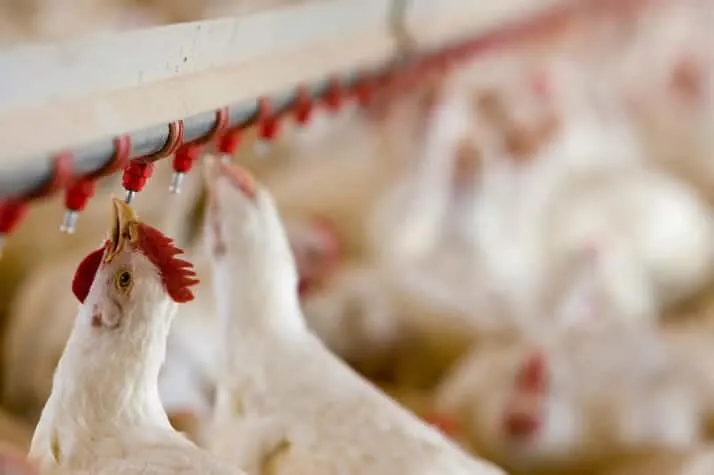
The vertical drinking nipple has many flaws.
First, they require the container to be suspended. A 5 gallon bucket full of water weighs about 40 pounds, which makes hanging them a challenge.
These hanging nipples are also awkward for a bird to drink from.
These types of nipples hold water internally. This means the nipples will freeze and break, or the pins freeze and cannot be activated. Even if a bucket heater is added, the bucket won’t be able to heat the water inside of the nipple.
Because the vertical nipples hold water internally, they are also difficult to clean.
Vertical nipples are also notorious for leaking and making a mess.
Columbus Aqua chicken nipples do not leak and even come with a lifetime leak free guarantee.
Horizontal Chicken Nipples vs Poultry Watering Cups
Chicken water cups are a popular alternative to vertical nipples, but they are not without their faults as well.

The chicken drinking cups are an autofill design that holds water for the bird to drink.
These cups can become a bacterial breeding ground (read about disease spread from waterers here), as they are simply small pools of communal water.
The chicken drinker cups also freeze easily. Even if a heater is used in the winter, it cannot keep the water in the cup from freezing.
Premade Chicken Nipple Bucket
You can find premade and heated chicken nipple buckets like the Premier 1 Heated Poultry Waterer at most farm supply stores.
These buckets do not use the genuine Columbus Aqua brand nipples and are very expensive considering what they are.
A DIY chicken waterer with Columbus Aqua chicken nipples and a 5 gallon bucket can be made at home for less than $15.00.
Horizontal chicken nipples vs traditional fount
Traditional founts are one of the worst styles of chicken waterers.
The open basin allows for wild birds and rodents to share water with your chickens, which can transmit disease.
This open waterer can also become contaminated with dirt and poop, and grows algae. They need to be scrubbed clean and filled with fresh water every day.
The plastic founts will eventually crack from being outside. Galvanized models eventually rust, and it’s not safe to use Apple Cider Vinegar in them.
These waterers have a lot of spillage and water loss from evaporation, meaning they need to be filled up more often.
If that’s not enough, they also freeze easily with their open reservoir design.

What Is The Best Chicken Waterer?
Columbus Aqua chicken nipples are the best chicken waterer.
Keep in mind, not all chicken nipples are made the same. In 2017 the side mount chicken nipple was copied by Chinese manufacturers. These lookalikes are made of poor quality materials and are known to leak or even fall apart.
The original chicken nipple is made by Columbus Aqua in Denmark. They have been producing these nipple waterers since the early 1990s. Columbus Aqua chicken nipples are BPA free, made with food grade HDPE plastic and premium stainless steel, and have an operating range of -30 degrees F to 190 degrees F.
Columbus Aqua chicken nipples do not leak and even come with a lifetime leak free guarantee.
Chicken Nipple Idea Board
Are you looking for inspiration on how to make a chicken nipple waterer? Take a look at our idea board!
This photo gallery is jam packed with suggestions on using the nipples on various buckets, containers, a plastic bottle, PVC, chicken nipple waterer 5 gallon buckets, chicken nipple waterer DIY designs, and other automatic chicken waterer systems.
You can also see how the nipples work with chickens, quail, peafowl, guinea fowl, and other birds. Clicking the photo will expand the image.
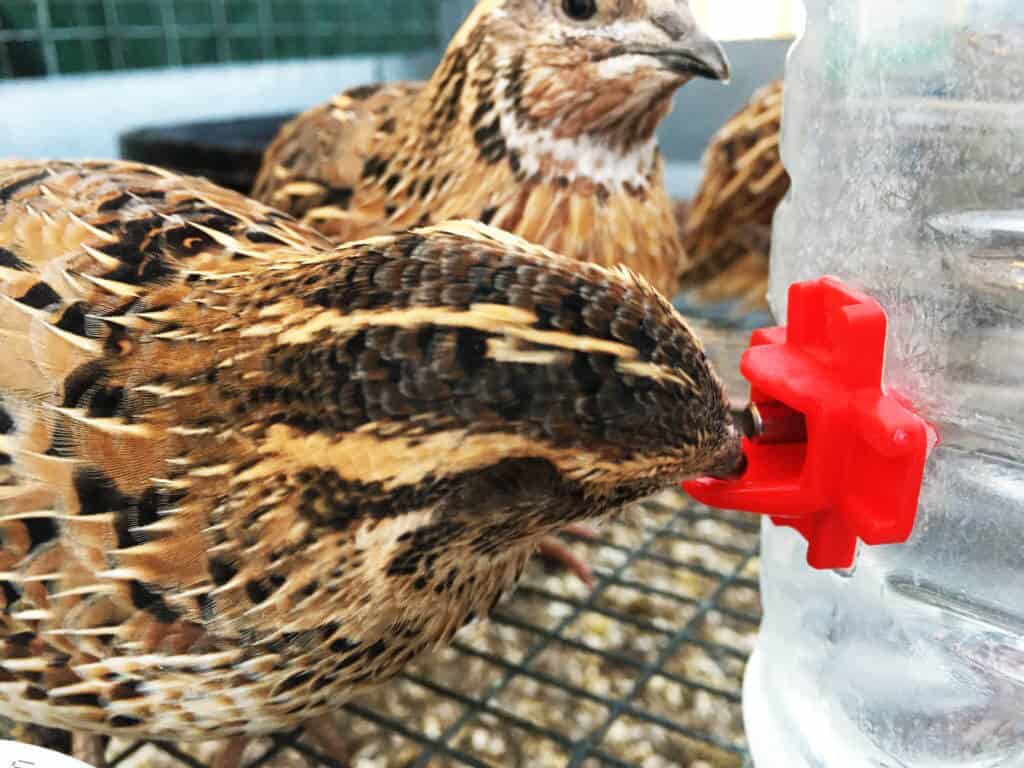
See the YouTube video here 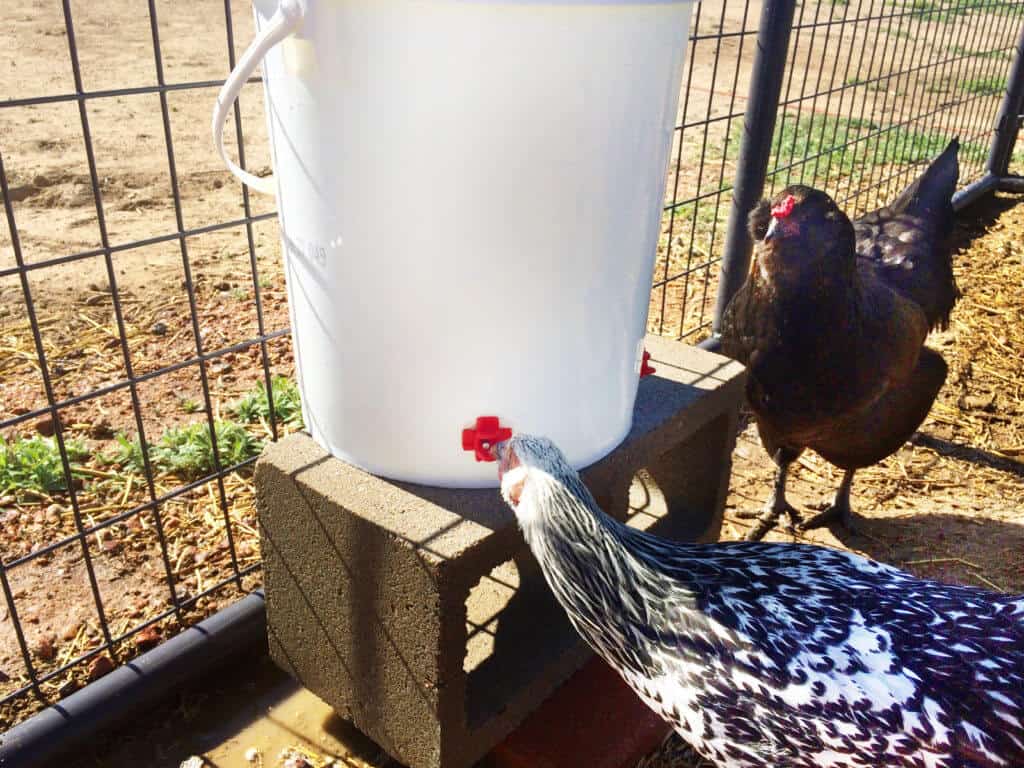
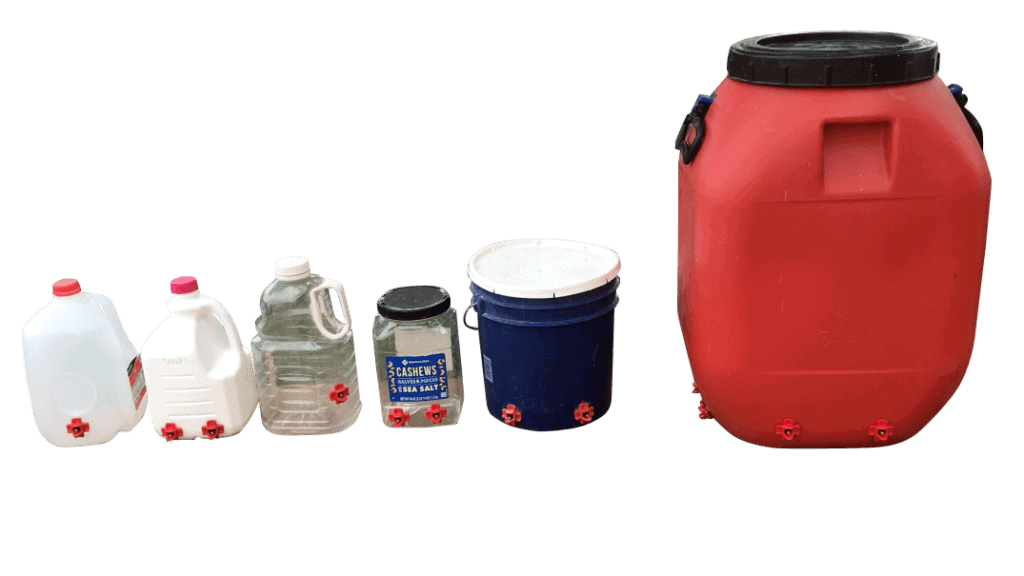
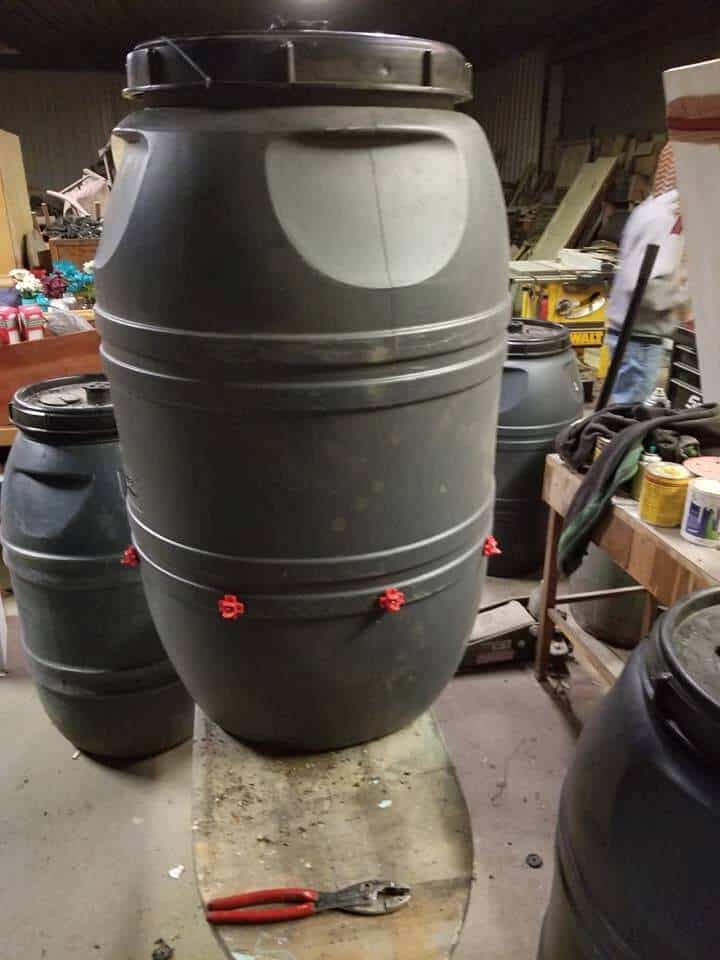
Premade and available from Billy Goldhammer on Facebook- https://www.facebook.com/billy.goldammer 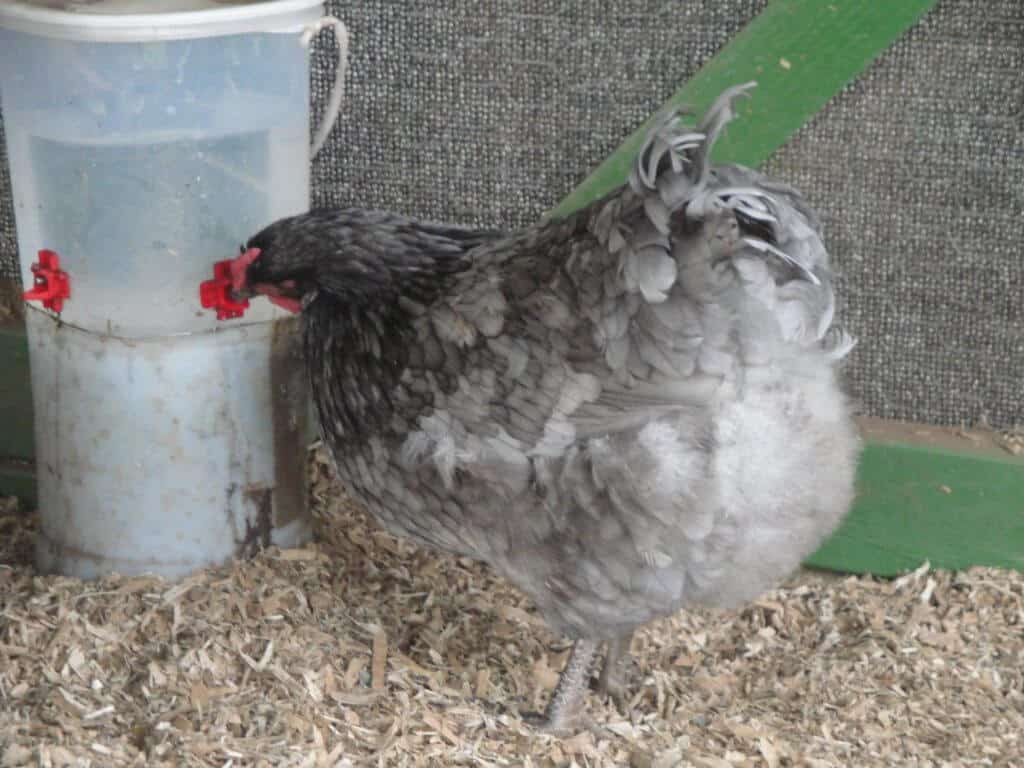
Courtesy Backyardchickens.com 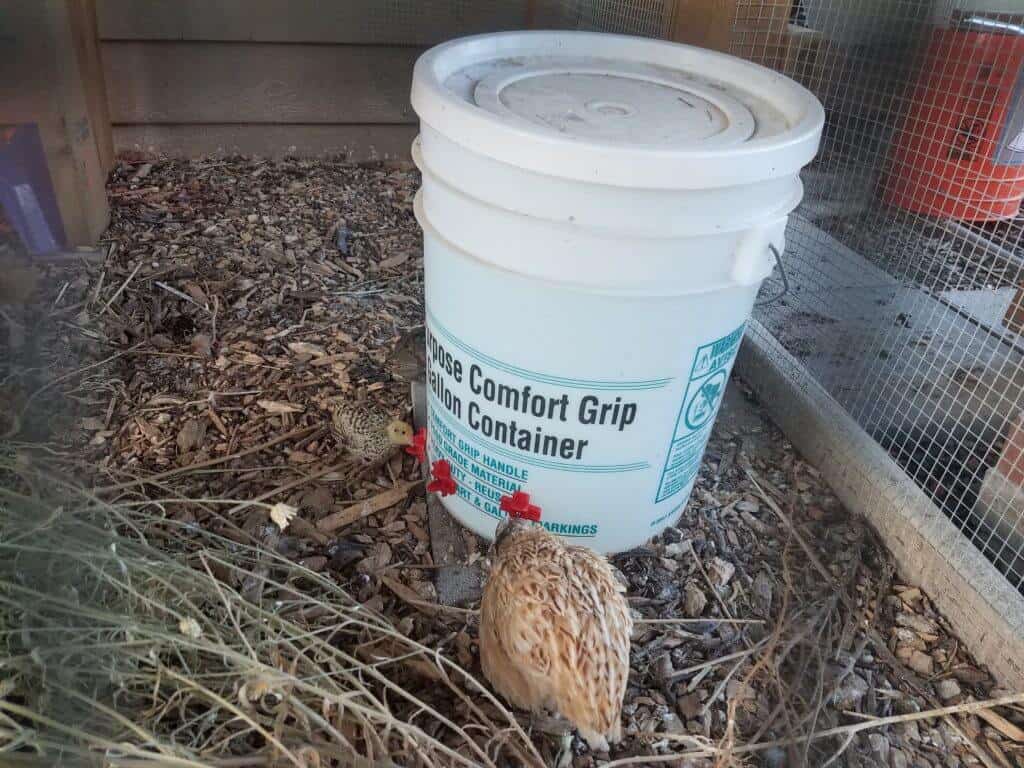
Even baby quail can use the nipples! (Baby is on the left) 
Courtesy Backyardchickens.com 

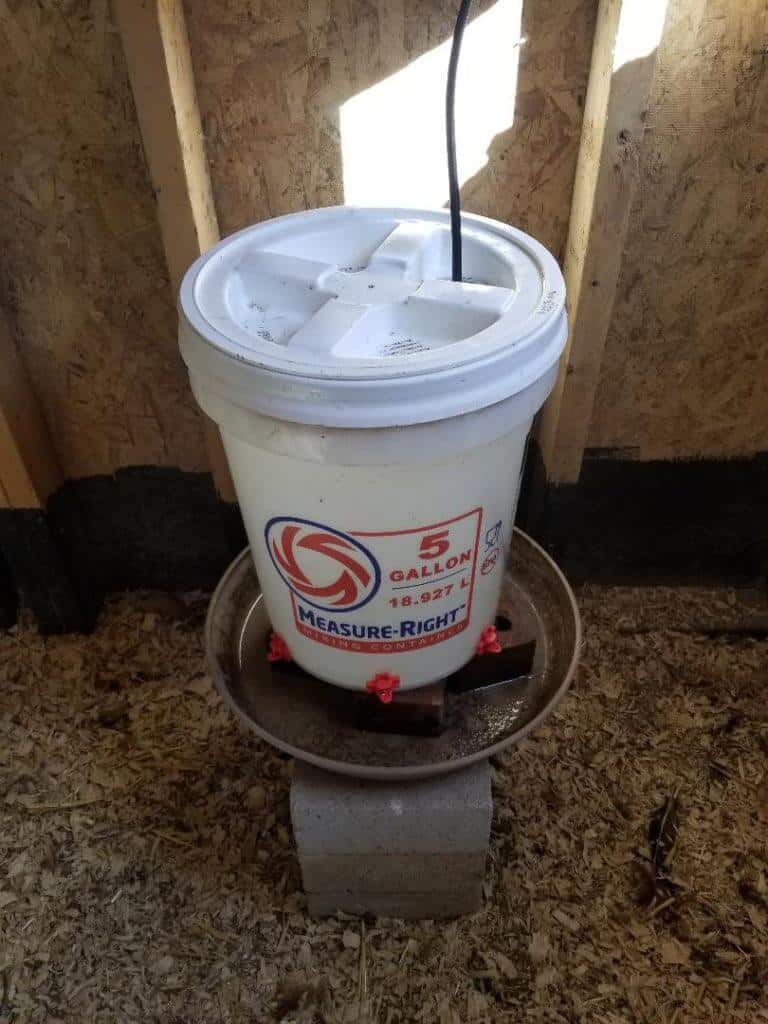
Courtesy Backyardchickens.com 
Courtesy Backyardchickens.com 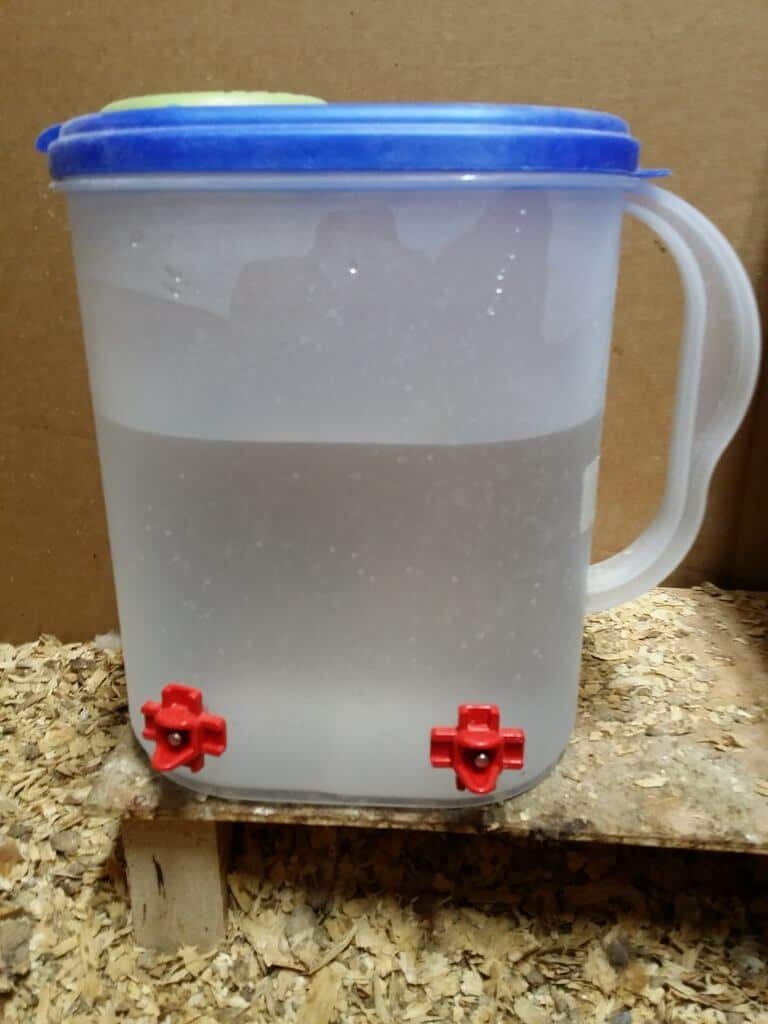
Courtesy https://www.backyardchickens.com/ 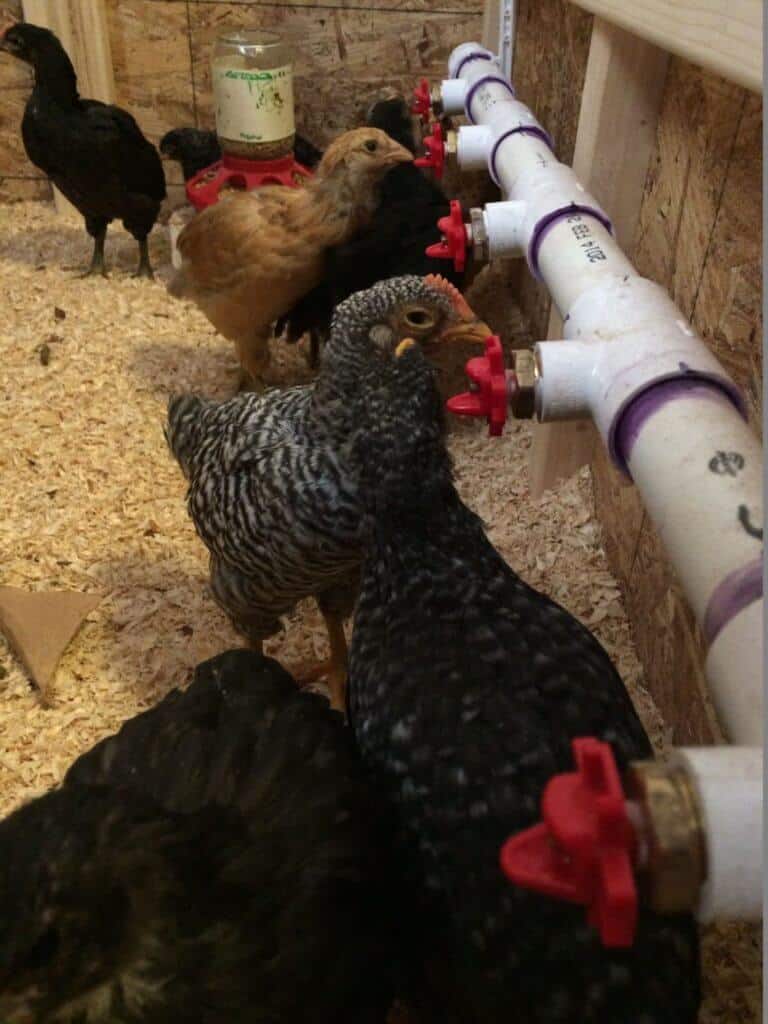


From https://homesteader.me/ 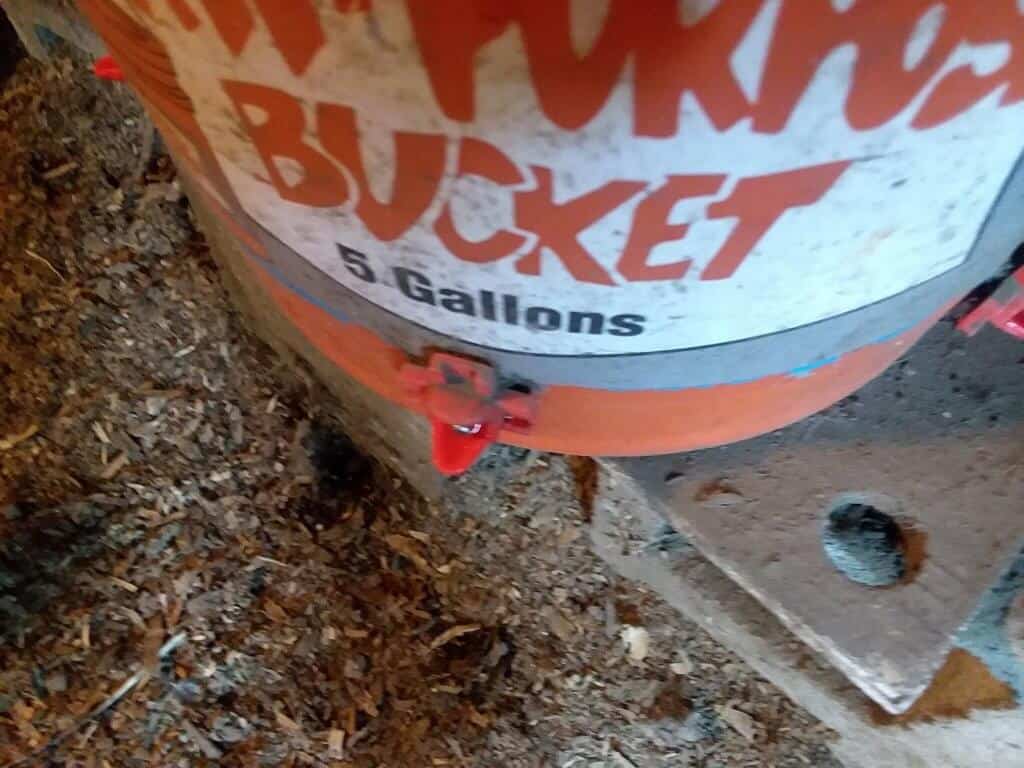
Courtesy Backyardchickens.com 
Courtesy Backyardchickens.com 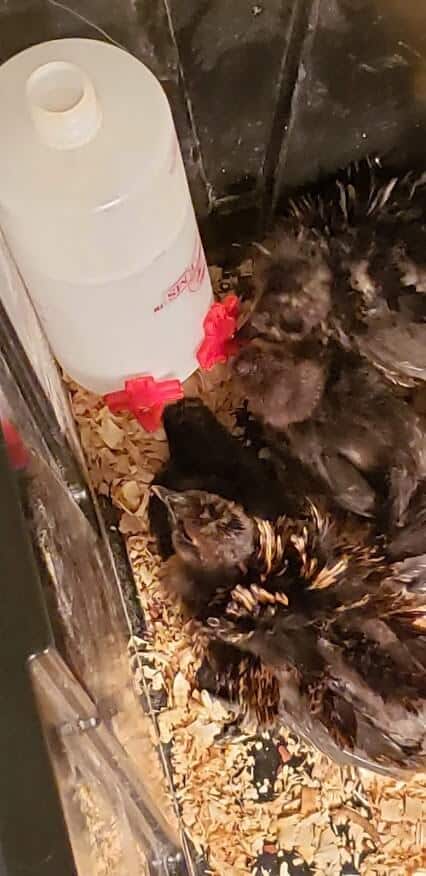
Courtesy Backyardchickens.com 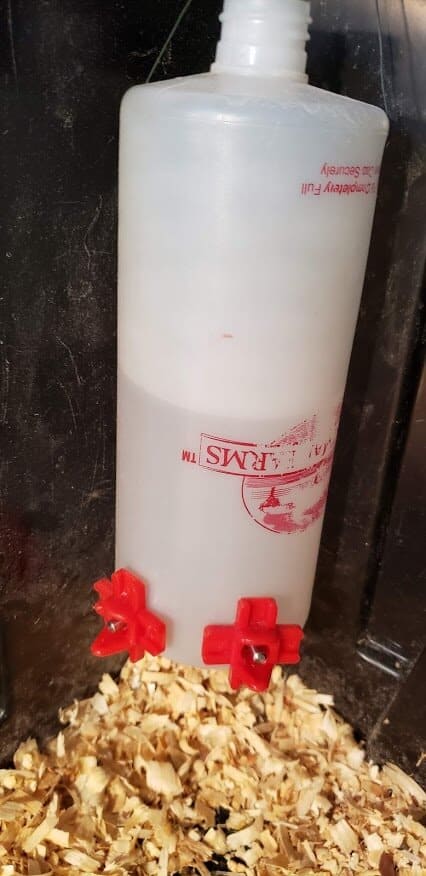
Courtesy Backyardchickens.com 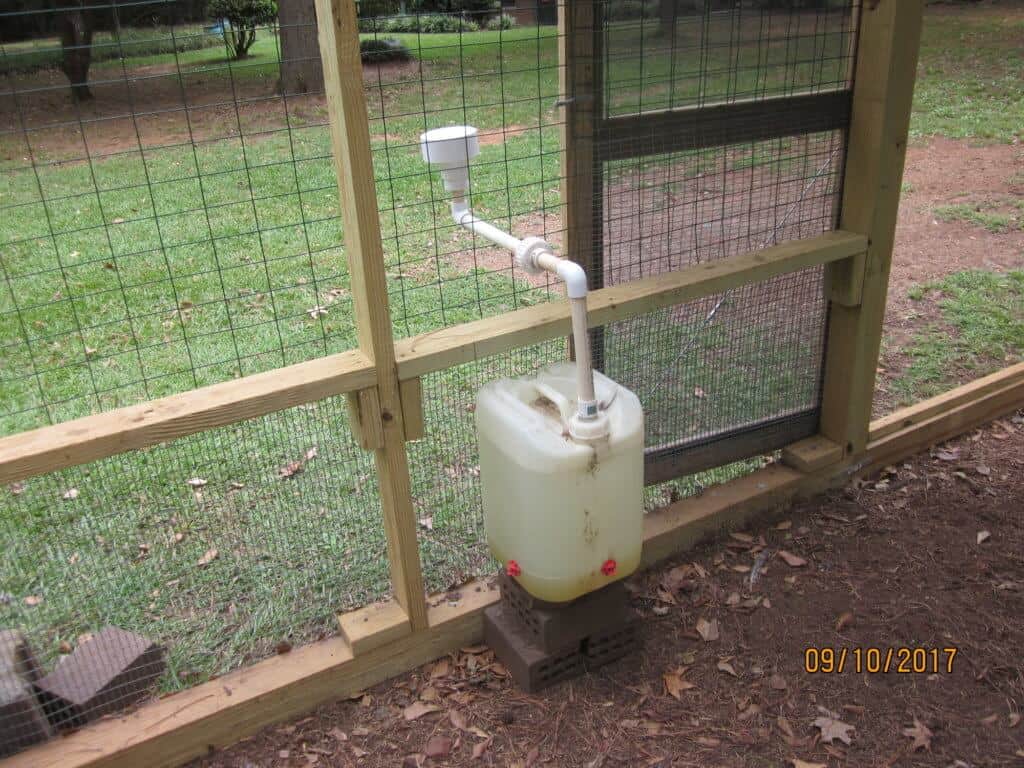
Courtesy Backyardchickens.com 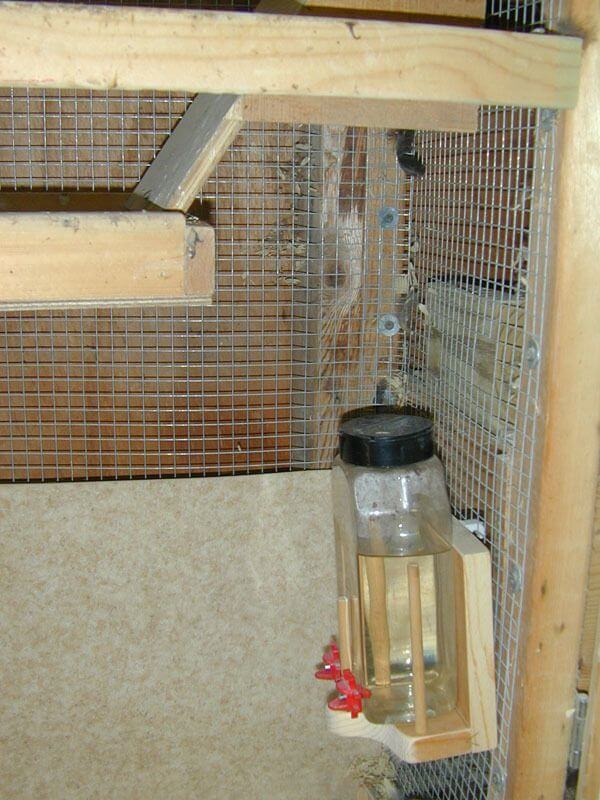
Courtesy Backyardchickens.com 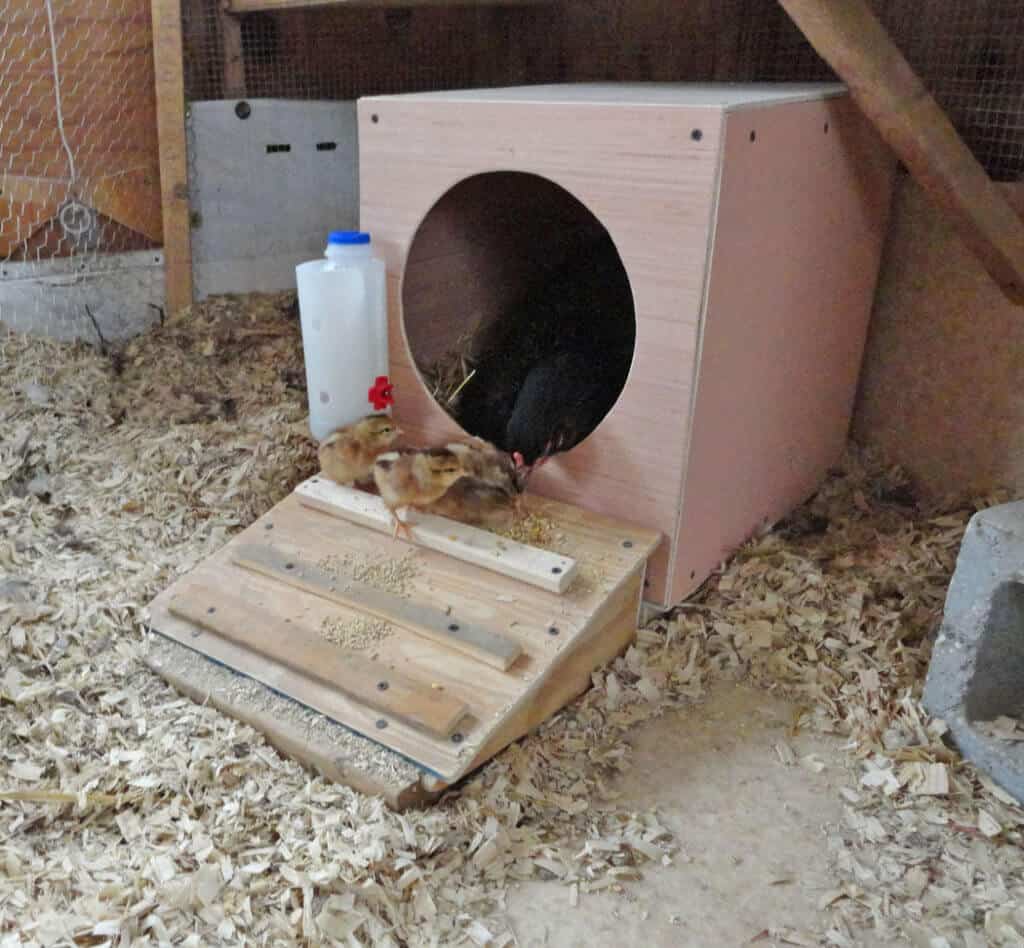
Courtesy Backyardchickens.com 
Courtesy Backyardchickens.com 
Courtesy Backyardchickens.com 

Will Ducks drink from chicken nipples?
Yes, ducks can drink from nipple waterers.
Although waterfowl can use these nipples, they also need to have a water source deep enough to submerge their nostrils to keep them clean and help them eat.
Not just for chickens
Nipples can be used with nearly any bird, including quail, pheasant, peafowl, guinea fowl, pigeons, and more.
They can also be used for mink, rabbits, mice, rats, and ferrets.
Inspiration for other uses
- Install a rain catch system on your chicken coop that can be used to fill your birds waterers
- If using a PVC system, add heated tape to keep water from freezing in the winter
- Add an auto fill system or float valve for automatic filling
- Make a “chick trainer” with 1-2 nipples and a juice bottle. Add the bottle to your brooder (along with their regular watering source) and oftentimes chicks will teach themselves! Switching chicks to nipple waterers prevent wet bedding from spilled water and stops dirty and poopy water that requires daily cleaning.
- Place a frozen milk jug in your flocks 5 gallon nipple bucket for cool and refreshing Summer water
How To Install Chicken Nipples
Before we get started, please note that these chicken waterer nipple installation instructions are only intended to be used with the Columbus Aqua horizontal/side mount chicken nipples which are made in Denmark.
The lookalikes that are available on Amazon are made in China and do not conform to the same standards as Columbus Aqua and their specifications vary widely. These instructions may work for generic chicken nipples as well.
Read on to learn how to install horizontal chicken nipples in detail.
How Many Chicken Nipples Do I Need?
Install one nipple for every 6-8 birds in moderate climates or one nipple for every 3-4 birds in hot climates.
Supplies Needed
Creating your own DIY chicken waterer can be as simple or as complicated as you want it to be. The simplest waterers are nipples installed on a 5 gallon bucket, while more complicated designs include automatic chicken waterer systems or recirculating PVC pipe designs.
In general, you’ll only need a few supplies.
- Container or PVC pipe
- Installation Tool (optional)
- Drill bit (and tap for PVC)
- Thread seal tape or silicone (optional)
- Pressure regulator (only for PVC applications)
Choosing A Container
Horizontal poultry nipples can be installed in nearly any plastic container, including PVC pipe, buckets, 55 gallon drums, juice containers, etc..
When choosing a container, pick one that is food grade or safe to use for drinking water. Some plastics can leach harmful chemicals. You’ll also need a container with thick plastic. A 2 liter bottle, for example, is too flimsy and won’t work well.
These nipples are intended to be installed on the side of a container, not on the bottom (like the vertical nipples). This allows the chicken waterer nipple bucket to be placed on a block, instead of being suspended.
If you are using PVC, Use 1/2” or larger Schedule 40 PVC pipe.
Installation Tool
The chicken nipple installation tool fits into a drill, making the process of screwing nipples in quick and easy.
It is an excellent addition to large and small DIY projects and for those with difficulty gripping or twisting which would hinder manual nipple installation.
While the tool is optional, it makes chicken waterer nipple installation much easier and is recommended.
Drill Bit & Tap
Because the Columbus Aqua nipples are made in Europe, the recommended drill bit is one that isn’t included in standard drill bit sets.
The recommended chicken nipple waterer drill bit size is an 11/32” drill bit.
If an 11/32″ is not available, you can use a 3/8” drill bit for holes, just be careful not to overdrill or the nipples will not seal well.
If you are installing the nipples on thick plastic or PVC pipe, the holes will need to be tapped. A tap adds threads to the thick plastic. Without the threads, the nipples (which have a threaded barrel) won’t have anything to grip onto and will pop out.
Thin plastic like a bucket does not need to be tapped.
chicken waterer nipple thread size
Thread seal tape or Silicone
An optional but recommended step is to use thread seal tape (teflon tape) or silicone to seal the threads during installation. Be sure not to get any silicone on metal pin or o-ring, and allow the silicone to dry completely before using.
Pressure Regulator
Nipples are intended to be used in a low pressure system, at less than 5 PSI. If you are hooking the PVC watering bar to a garden hose, a pressure regulator will be needed.
At pressures over 5 PSI, chickens won’t be able to physically press the pin due to the static pressure. If they are able to press the pin, water will come out too quickly to be consumed.
Installation
Chicken waterer nipple installation is as easy as drilling a hole and screwing them in.
Only screw the nipples into the container approximately 80%. They should not be flush mounted. Flush mounting will crack the container, which can no longer be used.
When screwing in the nipples, make sure that the nipple is installed level. This is because the inside of the threaded barrel of the nipple has a slight tilt, so when a chicken stops drinking, the nipple self drains.
This is very important, especially if you live in an area with below freezing temperatures. Since the nipple is designed not to hold any water internally, it can’t freeze. If the nipple is not installed level, it may not fully drain and could freeze.
Don’t forget to drill 1-2 small breather holes in the container lid to prevent a vacuum from forming. Without these holes, the waterer will not work properly.
How far apart should chicken nipples be?
Whether installing nipples on a bucket or PVC pipe, spacing is important. If the nipples are installed too close to each other, only one bird will be able to drink at a time.
If you have standard sized chickens (not bantam or large breeds), space the nipples about 12 inches apart.
What about a washer or nut?
Some sellers on Amazon include a washer or nut in their make your own waterer kit. This washer or nut is not a necessary installation piece.
Chicken nipples should only be screwed in about 80%. These washers are only used to stop the nipple from being screwed in all the way by mistake.
Other sellers include a nut that threads onto the nipple barrel to keep the nipple in place. This is also an unnecessary piece.
It is possible that the Chinese made lookalikes do not have tall threads and could slip out of the hole.
The Columbus Aqua nipples have tall threads that grip the plastic well. There is no need to use a nut with the Columbus Aqua brand.
How To Install Chicken Nipples On A Bucket
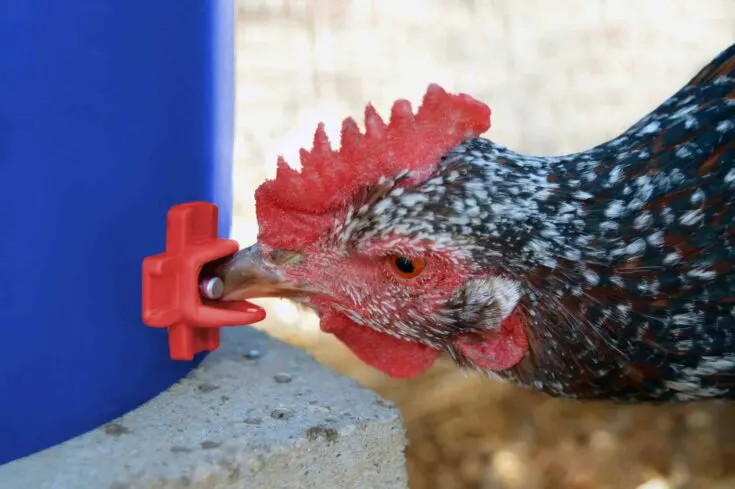
Creating your own DIY chicken waterer can be as simple or as complicated as you want it to be. The simplest waterers are nipples installed on a plastic container like a 5 gallon bucket or 55 gallon drum.
Materials
- Chicken nipples
- Bucket or container
- Nipple Installation Tool (optional)
- Thread seal tape or silicone (optional)
Tools
- Drill
- 11/23″ or 3/8″ drill bit
- 1/8-27 NPT tap
Instructions
- Mark drill holes on the side of the bucket, spaced at least 1" from the bottom

- Drill holes

- [Optional] Wrap threaded barrel of the chicken nipple with thread tape. Be sure the thread tape does not touch the metal pin or o-ring.
- Screw nipples into bucket approximately 80%. They should not be flush mounted. Flush mounting will result in cracked plastic. The installation tool allows nipples to be quickly screwed in with a drill.

- Drill 1-2 small breather holes in the container lid to prevent a vacuum from forming.

Notes
- Install 1 nipple for every 6-8 birds (or 1 per 3-4 birds in hot climates) spaced 10-12″ apart
- For proper operation, nipples should be screwed in straight, and bucket should be placed on a level surface
How To Install Chicken Nipples in PVC pipe
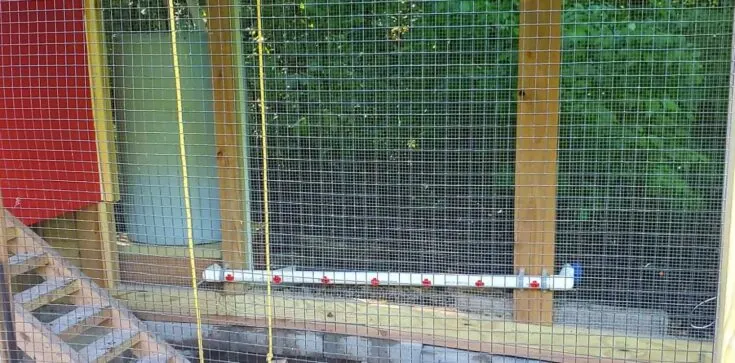
You can easily make a chicken nipple waterer with PVC pipe.
PVC chicken waterers can either be supplied with a water reservoir, or hooked up to a garden hose to make automatic chicken waterer. You will need additional PVC parts and other supplies depending on your design.
Materials
- Chicken nipples
- ½” or larger Schedule 40 PVC pipe
- Nipple Installation Tool (optional)
- Thread seal tape or silicone (optional)
- Pressure regulator (only if connecting PVC to a garden hose)
Tools
- Drill
- 11/23″ or 3/8″ drill bit
- 1/8-27 NPT tap
Instructions
- Mark drill holes on PVC, spaced 12" apart
- Drill holes
- Tap holes
- Wrap threaded barrel of the chicken nipple with thread tape. Be sure the thread tape does not touch the metal pin or o-ring.
- Screw nipples into pipe approximately 80%. They should not be flush mounted. Flush mounting will result in cracked PVC. The installation tool allows nipples to be quickly screwed in with a drill.
Notes
- Install 1 nipple for every 6-8 birds (or 1 per 3-4 birds in hot climates) spaced 12″ apart
- Nipples are intended to be used in a low pressure system. A pressure regulator should be used if needed, and set to no more than 5 PSI.
- If you are installing the nipples on thick plastic or PVC pipe, the holes MUST to be tapped. A tap adds threads to the thick plastic. Without the threads, the nipples (which have a threaded barrel) won’t have anything to grip onto and will pop out.
Winter Modifications
Most chicken nipple waterer systems can be used year round with some slight modifications.
When properly installed, the nipples themselves won’t freeze. This is because the inside of the barrel of the nipple has a slight tilt, so when a chicken stops drinking, the nipple self drains. Since the nipple is designed not to hold any water internally, it can’t freeze.
Even though the nipples won’t freeze, the water inside of the bucket can. The simple fix is to make a heated chicken nipple water feeder by adding a submersible heater. The heater must be one that sits on the bottom on the bucket, close to the nipples. A floating heater won’t work.
For 5 gallon buckets I like this 80w heater, and for 55 gallon drums I use this 250w heater.
For static waterers like a 5 gallon bucket, just add a submersible heater when the temperature starts to drop.
PVC chicken waterers will need a little more creativity. Some folks have created heated, recirculating watering systems, or wrap the PVC in heat tape.
In order to help save on water heating costs, consider adding a Thermocube. This brilliant invention is a thermostatically controlled switch. It turns the bucket heaters on at 35 degrees, and off at 45 degrees.
If you use a Thermocube, keep in mind that the Thermocube itself needs to be exposed to the outside temperatures. If you put the Thermocube in an insulated garage or shed, it won’t be exposed to the cold temperatures and won’t work correctly.
Free DIY Chicken Nipple Waterer Blueprints
If you would like additional guidance on creating your DIY chicken waterer, be sure to download these free DIY chicken nipple waterer blueprints.
This ebook includes step by step instructions on how to make 5 different chicken nipple waterers, plus illustrated diagrams, shopping lists, and how to choose which design is best for you.
What’s Inside
This free 23 page ebook includes:
- How to choose a chicken watering system that best suits your needs
- 3 easy to make bucket waterers
- Brooder water bottle designed to train your chicks without worry
- How to install chicken nipples in PVC pipe
- 3 unique PVC watering bars
- 2 PVC water bar autofill options
- How to make an automatic chicken waterer
- Shopping list
- Additional resources
Each design includes a list of tools and supplies needed, assembly steps, and diagrams with a shopping list.

My chickens never drink one drop of dirty water! I have achieved this by installing the nipples in a 5 gallon bucket with a lid. The bucket has an internal float valve hooked to a garden hose. The water level gets so high then shuts off ( at 4.5 gal). No more caring water for me! 5 nipples installed and it keeps 25 chickens happy.
Dave S.
Get the FREE DIY Chicken Nipple Waterer Blueprints by completing the form below!
Note: If you don’t see the email in your inbox, please check your junk folder or search your mailbox for [email protected]
Chicken Nipple Waterer Setup
Now that you have finished making your chicken nipple waterer, it’s time to set it up.
Proper setup is simple and will eliminate many problems, as well as making it easier for your chickens to use.
chicken nipple waterer height
Chicken nipple waterers should be placed on blocks so nipples are at the birds neck or shoulder level. Stacked cinder blocks work well for this.
If you have flocks of mixed sizes, try picking a height in the middle. You can always add a block for smaller birds to stand on.
You can also add more chicken nipples on the bucket at varying heights.
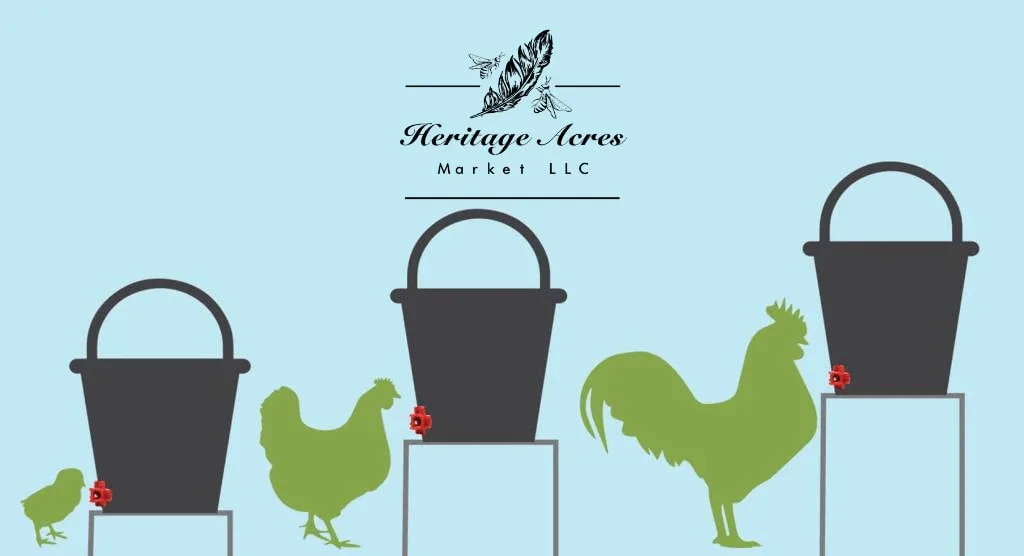
Make sure waterer is level
As noted earlier, it is important that the nipples remain level so that they can self drain properly.
While the chicken nipples should be installed levelly, it is also important that the bucket placed on a level surface. If the nipples were installed level, but the bucket is not level, the nipples may not self drain correctly.
Finally, make sure the bucket has been filled completely, and vent holes in the lid are not missing or clogged.
Training Chickens To Use Nipple Waterers
For this training guide, it is assumed that you’ve installed the chicken water nipples onto a 5 gallon bucket. The process is the same regardless of the container used, it is simply the most common setup.
Consider placing the bucket in the pen on the day before training, so the birds have time to get used to it and no longer be afraid of its presence. They can sometimes find the new bucket scary at first.
Chicken nipples are intended to be used with chickens 2+ weeks old, in most cases. For birds such as quail, pheasant, or other smaller birds, wait until they are old enough to be able to press the nipple pin.
Training
Teaching chickens to drink from nipple waterers is usually a quick process and often done in less than 30 minutes. Some flocks may need a little more time.
Remove All Other Waterers
When ready to train your birds, remove all other water sources. This is critical, and the number one reason chickens don’t learn how to use the nipple waterer.
If all other water sources are not removed, birds will have no motivation to learn to use the chicken nipple waterer.
During mild weather, remove the original waterer the night before. Chickens don’t drink water at night anyways. Then, the next morning, chickens will be ready to learn.
If the weather is hot, above 80 degrees F, remove the original waterer about an hour before you are ready to teach your chickens to drink from the nipple waterer.
Natural Attraction
Chickens are naturally attracted to the nipples red color. In fact, if you put the waterer in the pen a day or two before officially training them, they are likely to figure it out on their own.
Press the pin, allowing the water to flow from the chicken nipple. Try this several times while birds are watching. You can get their attention by sprinkling treats around the waterer.
Continue this until one bird drinks, and others will then follow. If birds do not drink after several minutes of pressing the pin, try again in 30 minutes.
Do not return birds usual water source between training sessions if you working with them every 30 minutes. If your chickens have not used the new waterer within in a few hours and it’s above 80 degrees F, give them their original waterer and try again the next day.
Birds will often figure out how to use their new waterer within just a few minutes of the first training session.
A Little Help
In some cases, you may need to gently press a birds beak into the nipple until it flows water.
This is especially true for quail and young birds. This is similar to dipping a chicks beak into their water when moving them to the brooder for the first time.
Laser Pointer
You may also find success in guiding birds to drink with a laser pointer. As the birds chase and peck at the laser pointer, have the birds follow the dot to the chicken nipples. When they peck the nipples, they should quickly figure out how to use them.
Mark The Water Line
When training new birds to use the chicken nipples, I find it helpful to mark the water line on the container and check back in a few hours.
If the water level has dropped, I know the birds are drinking from them, and I no longer need to sit and watch them for hours just to make sure.
Keep in mind that checking the water line too soon may not show a noticeable drop in water, especially if nipples are on a 5 gallon bucket and you only have a few birds.
The water level will drop faster when the weather is hot, the nipple container is smaller, and you have more chickens using it.
If the weather is cooler, the nipple container is larger (like a 55 gallon drum) or you only have a few chickens, the water line will take longer to drop.
One solution is to use a small container like a clear juice jug just to train the chickens on. It’s easy to watch the water line, and being a smaller container the water level will drop more quickly with use. Once you are comfortable with your birds using the nipple waterer, you can then switch your flock to a bucket waterer.
How much water does a chicken drink per day?
There are a lot of variables that determine how much a water a chicken drinks per day, like the size of the chicken and how hot it is outside.
The rough rule of thumb is that a single adult chicken will drink about a pint of water a day.
If you are monitoring the water line on your new chicken nipple waterer, a pint of water drank from a 5 gallon bucket would hardly move the water line. This is why you’ll need to wait a few hours before checking.
Troubleshooting
If your poultry nipples are not working as expected, the root cause can easily be narrowed down and fixed.
Is it a Columbus Aqua?
First, verify the nipples are made by Columbus Aqua. Columbus Aqua is the original manufacturer of the side mount/ horizontal chicken nipple.
The Chinese lookalikes are known for leaking and falling apart, or havcolue stiff springs that are too hard for chickens to press.
Columbus Aqua chicken nipples have been on the market for many years, and their quality has proven itself time and again. They do not leak and even come with a lifetime leak free guarantee.
You can look for the Columbus Aqua mark on the back of the nipples.

Quick Guide
Below is a quick guide with common problems and solutions. These are also covered in more detail after the quick guide.
| Problem | Cause & Solution |
|---|---|
| NO WATER COMING FROM NIPPLES | Vapor lock (drill hole in lid) Birds are too young and can’t press pin (try again in a week) Wrong height (adjust nipples to shoulder height so birds can press pin easier) Not Columbus Aqua brand (other brands have stiff springs that are hard to press) Check water level (is there water in the container?) Check for clogs (especially if using a rain catch system) |
| WATER LEAKING FROM THREADS OR CONTAINER | Container is too thin (use a thicker plastic like a bucket) Hole drilled is too big (use 11/23″ or 3/8″ drill bit) Hole is cracked (either the nipple was screwed in flush stretching/cracking the container, or the container plastic was weak. Thread tape or silicone may work, but usually the container needs replaced) Screw nipple in further (nipple should be screwed in 80%. Less could cause leaking) |
| DRIP OR LEAK FROM PIN | Normal (some dripping is normal when the birds drink) O-ring not seated (press pin to reseat or look inside the container to see if something is stuck in the o ring) Broken or missing o-ring (unscrew nipple or check inside the container. If o-ring is damaged or missing, contact us for a replacement) Not Columbus Aqua (other brands are prone to leaking) |
| NIPPLES POP OUT FROM PVC | Holes must be tapped (PVC holes need threaded for nipples to grip onto) |
| BIRDS ARE NOT USING NIPPLES | Birds are too young and can’t press pin (try again in a week) Remove old waterer (birds will not want to use a new waterer with the original one present) Train Birds to use nipples (see our Training Guide) Vapor lock (drill hole in lid) Mark water line on container and observe (often birds are drinking fine) |
| BIRDS SEEM THIRSTY | Press pin with finger and confirm nipples are working Check water (is the container empty?) Mark water line on container and observe (often birds are drinking fine) Note: many customers worry because chickens will rush to puddles or similar to drink. However this is normal behavior, just as they rush to treats even when well fed. As long as nipples are function properly (test by pressing the pin with your finger) and you observe the water line dropping, the birds will be ok |
Nipple Does Not Release Water When Pin Is Pressed
Check vent hole
A common complaint is that the chicken nipples aren’t releasing water when the pin is pressed.
This is almost always because the vent holes are clogged, or were never drilled. Clogged or missing vent holes results in the container vapor locking, essentially creating a vacuum, and no water can be released.
Every time the bucket is cleaned, give the vent hole a quick check.
The bigger the vent hole the less likely it will clog, however it could allow more dirt to get into the bucket. A smaller hole is less likely to let dirt in, but it could clog over time.
If you do not have a vent hole in the lid of your chicken nipple waterer lid, you’ll need to add one.
CHECK THE WATER LEVEL
Look inside of the bucket. Is the water level above the nipple? If not, fill the bucket and try again.
CHECK FOR NIPPLE CLOGS
Since the horizontal chicken nipples do not mount to the bottom of the bucket like the vertical nipples do, clogs are very unlikely.
However if you have a rain catch system that fills the nipple bucket, it is possible debris could have clogged the nipple.
Clean the container and refill with fresh water, and check nipple again. If it is still not working, unscrew the nipple and check the o-ring.
Bucket Is Leaking Around The Nipple
There are two main reasons the bucket is leaking around or at the base of the chicken nipple.
BUCKET IS CRACKED
Over years of being outside, it is not uncommon to find the bucket has cracked near the hole that was drilled for the nipple.
Due to being in the sunlight and exposure to heat and cold, cracks may form. If the chicken nipples are screwed in too far the bucket will also crack.
In some cases the cracks can be sealed with aquarium grade silicone or plastic welded. If using a 5 gallon bucket, it is usually easier to simply replace the bucket.
HOLE IS TOO BIG OR THREADS ARE LEAKING
If the hole in the bucket was drilled too large, or your container is thick walled (ie 55 gallon bucket or pvc) or thin walled (ie milk jug or 2-liter bottle), it can also leak.
If you have a thick walled container, it should be tapped (see chicken waterer nipple installation). Try wrapping the threads in Teflon tape and see if the leaking stops.
Thin plastic (like a 2 liter bottle) does not work well with the chicken nipples and should be replaced with something like a 5 gallon bucket.
If the hole was drilled too big, or the nipple was screwed in all the way and expanded the hole, it is usually best to replace the container and start over.
PVC holes need to be tapped or the nipples will pop out or leak.
Chicken Nipples Are Leaking Or Dripping
Normal with use
When the birds use the nipples, sometimes more water is released than the bird can drink. The nipples are also self-draining (so that no water is stored inside the barrel).
This can result in a small amount of water dripping after or between use. There should not be more than a few drop. However, if birds are using the nipples often, and the nipple leaves a few drops between birds, this can add up to a small puddle under the waterer.
When the nipple pin is pressed, the o-ring is moved out from the groove in the barrel (the threaded part), allowing water into the nipple. When the hen stops drinking, the o-ring seals the barrel stopping water flow.
The barrel is tapered and self draining. So, when the bird stops drinking, there will be about 3-5 drops of water as the barrel empties. This keeps the barrel clean, but also is why they don’t freeze- they don’t hold water.
Keep in mind there are 3-5 drops after EVERY TIME the pin is pressed. When each bird presses the pin several times, and birds are regularly drinking from them, these drops can add up to small puddles.
Also, some birds are messier drinkers and not able to drink all of the water that is released from the chicken nipple, while others keep the pin pressed and the water flowing while they drink.

The main thing to look for is dripping between birds drinking. After a bird drinks and the barrel self drains the 3-5 drops, is there any further dripping? Dripping when not in use in indicative of a faulty chicken nipple
EXCESSIVE LEAKING
If you find a chicken water nipple leaking or dripping excessively, there may have been damage to the O-ring, or debris caught between the O-ring and threaded barrel.
First, check to make sure the O-ring is present, undamaged, and sitting in the groove on the pin.
If the O-ring is normal, look to see if there is any debris caught between the O-ring and barrel. You may need to unscrew the nipple and rinse it under running water while pressing the pin.
If the water inside of the bucket is clean you can leave the poultry nipple in place and press the pin, allowing water to run through and flush out the nipple.
If the nipple continues to leak, please contact us for troubleshooting and our Columbus Aqua Lifetime Leak Free Guarantee.
My Birds Won’t Drink From The Nipples
This is a commonly reported problem, and one that has several solutions.
ARE YOUR BIRDS OLD ENOUGH TO BE ABLE TO PRESS THE PIN?
For chickens, we recommend using these for birds 2+ weeks old, although many have told me they use them with younger birds.
Quail, bantam chickens, pheasants and other birds may need to be older (closer to 1 month) before they are physically able to press the pin
HAVE YOU SUCCESSFULLY TRAINED THE BIRDS TO USE THE NIPPLES?
Your chickens will likely need a little help and for you to show them how the waterer works. You can read how to do this in the Training section.
HAVE ALL OTHER WATER SOURCES BEEN REMOVED?
When training birds to use the nipples, they will always resort to their original water source.
It is extremely important to remove ALL water sources except for the nipple container after your chickens are trained on the nipple waterer. If all other sources are not removed, the birds may not use the nipples.
If you live in a hot climate, work to teach the birds how to use the nipples for a few hours following the training guide.
After a few hours, if you do not feel the birds have an understanding of the nipples, you may give them their original waterer back while leaving the nipple waterer with the flock as well. Repeat this process over the next few days.
If you are unsure whether or not the birds are using the nipples, monitor the water level. You’ll likely find that the birds are in fact using the waterer.
HAVE YOU MONITORED THE WATER LEVEL?
In traditional founts, there is a lot of water loss due to evaporation and spillage.
When transitioning to nipples, you will not have to fill water containers as often, which could lead to concerns about your chickens drinking enough water.
When training new birds to use the nipples, I find it helpful to mark the water line on the container and check back in a few hours.
If the water level has dropped, I know the birds are drinking from them, and I no longer need to sit and watch them for hours just to make sure.
Keep in mind that checking the water line too soon may not show a noticeable drop in water, especially if nipples are on a 5 gallon bucket and you only have a few birds.
The water level will drop faster when the weather is hot, the nipple container is smaller, and you have more chickens using it.
If the weather is cooler, the nipple container is larger (like a 55 gallon drum) or you only have a few chickens, the water line will take longer to drop.
One solution is to use a small container like a clear juice jug just to train the chickens on. It’s easy to watch the water line, and being a smaller container the water level will drop more quickly with use. Once you are comfortable with your birds using the nipple waterer, you can then switch your flock to a bucket waterer.
My Birds Rush To Puddles Or Seem Thirsty
Many people worry that their chickens are not receiving enough water from the poultry nipples because the birds will run to a puddle or other water source and drink.
Rest assured, this is a “chicken thing”. We have used exclusively the side mount nipples for years with our mixed flock. Our summertime temperatures are in the 100’s on a regular basis, and we have NEVER lost a bird to dehydration.
This activity is similar to a well fed chicken excitedly running over for a handful of treats. The chicken is not hungry, it probably has access to food all day. But, they still enjoy the treats and will gobble them up.
Just because a chicken drinks out of an alternate water source does not mean the birds is dehydrated.
As long as the nipples are working correctly (water coming out when the pin is pressed), and the chickens have been trained to and are using the nipple waterer, your birds are certainly getting more than enough water.
If you are still concerned that your birds are not drinking, consider marking the water line and checking it in several hours.
You can see in the video below how much water is actually released when the chicken use the nipple waterer. There is more than enough water for them to drink.
Nipples Froze And No Water Comes Out
The Columbus Aqua nipples themselves are unable to freeze, as they do not hold any water inside (like the vertical nipples do). However, if the water inside of the bucket freezes with even a thin layer of ice, the birds may not be able to press the pin to release water.
Depending on your winters, there are a number of simple fixes available.
Are the nipples and the bucket level?
When screwing in the nipples, make sure that the nipple is installed level. This is because the inside of the threaded barrel of the nipple has a slight tilt, so when a chicken stops drinking, the nipple self drains.
This is very important, especially if you live in an area with below freezing temperatures. Since the nipple is designed not to hold any water internally, it can’t freeze. If the nipple is not installed level, it may not fully drain and could freeze.
While the nipples should be installed levelly, it is also important that the bucket placed on a level surface. If the nipples were installed level, but the bucket is not level, the nipples may not self drain correctly. If they don’t self drain and hold water, they could freeze. This is just about the only cause of a chicken nipple waterer freezing.
ADD A BUCKET HEATER IN THE WINTER
Even though the nipples won’t freeze, the water inside of the bucket can. The simple fix is to add a submersible heater. The heater must be one that sits on the bottom on the bucket, close to the nipples. A floating heater won’t work.
For 5 gallon buckets I like this 80w heater, and for 55 gallon drums I use this 250w heater.
For static waterers like a 5 gallon bucket, just add a submersible heater when the temperature starts to drop.
In order to help save on water heating costs, consider adding a Thermocube. This brilliant invention is a thermostatically controlled switch. It turns the bucket heaters on at 35 degrees, and off at 45 degrees.
If you use a Thermocube, keep in mind that the Thermocube itself needs to be exposed to the outside temperatures. If you put the Thermocube in an insulated garage or shed, it won’t be exposed to the cold temperatures and won’t work correctly.
BRING BUCKET INSIDE AT NIGHT
Chickens do not drink water at night, so one simple way to keep their chicken nipple waterer from freezing is to bring it inside in the evening and take it back out in the morning.
PAINT IT BLACK
If you live in mild climates, consider using black containers or paining the nipple bucket black. This will allow the winter sun to thaw any thin layers of ice that may have formed overnight.
WATER IN THE NIPPLE CUP FROZE
Although this does not happen often, it is possible for water in the cup (or lip) below the pin to freeze. This is more likely in extremely cold temperatures.
Check to make sure the nipples and bucket are level. This is very important, since the nipple is designed to self drain and not to hold any water internally. If the nipple is not installed level and the bucket is not level, it may not fully drain and could freeze.
You could also drill a small hole in the catch cup for the water to drain, or cut the lip off.
FAQ
Many people worry that their chickens are not receiving enough water from the poultry nipples, as the birds will run to a puddle or other water source and drink. Rest assured, this is a “chicken thing”.
This is much like a well-fed chicken excitedly running over for a handful of treats. The chicken is not hungry, it probably has access to food all day. But, they still enjoy the treats and will gobble them up.
We have used exclusively the side mount nipples for years with our mixed flock. Our summertime temperatures are in the 100’s on a regular basis, and we have NEVER lost a bird to dehydration.
The easiest and most hygienic way to make a waterer out of a 5 gallon bucket is by using Columbus Aqua side mount chicken nipples like the ones pictured here.
While ducks can and will drink from side mount nipples, they also need a dish deep enough to submerge their nostrils to clean them.
A watering bucket should be placed on blocks so that the nipples are at the birds neck level.
Install 1 nipple for every 6-8 birds in mild climates, or 1 per 3-4 birds in hot climates.
Columbus Aqua chicken nipples are the best waterer for chickens! They keep water perfectly clean, don’t leak, and allow buckets to be set on a block instead of hung.
Poultry nipple waterers are a spring loaded, pin activated water dispensers that can be installed on the side of nearly any plastic container. When a chicken pecks at the pin, the o-ring is moved out from the groove in the barrel (the threaded part), allowing water into the nipple. When the hen stops drinking, the o-ring seals the barrel stopping water flow.
Teaching chickens to drink from nipple waterers is usually a quick process and often done in less than 30 minutes, but some flocks may need a little more time. Here is the complete guide to teaching chickens to drink from nipple waterers.
One of the easiest ways to eliminate algae problems is by switching to a Columbus Aqua chicken nipple waterer. Nipple waterers keep the water away from the sunlight, so no algae forms
Chicken nipples are the easiest, most affordable, and healthiest way to give your chickens water. A poultry nipple drinker is a spring loaded, pin activated water dispenser that can be installed on the side of nearly any plastic container like a bucket, Tupperware, or 55 gallon drum, or PVC pipe.

Lisa
Wednesday 24th of August 2022
Can you install the nipples on the water container at different heights, so it can be used better as chicks grow? Also, we found it necessary to drill a tiny hole at the top of the container, otherwise the nipples didn't function correctly. Then a we fill the container, we assure the water level doesn't go past that hole.